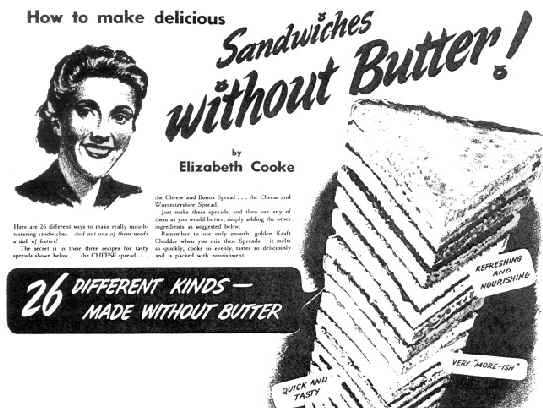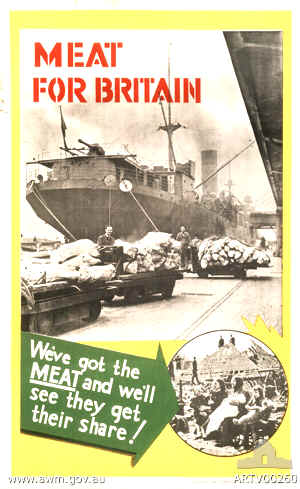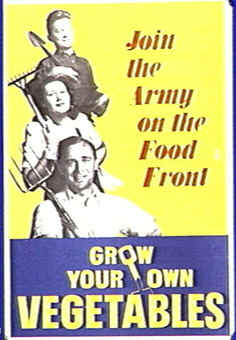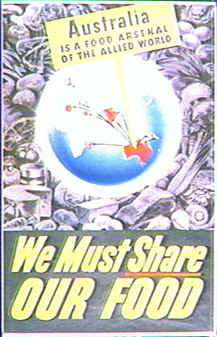|
Food
in the war years - rationing and new tastes
As part of the Curtin Government's
'Total War' strategy, certain foods began to be rationed in 1943. An
important part of the Australian war effort was the provision of food to
servicemen in our region, as well as the provision of food parcels to
Britain. Rationed goods included tea, sugar, beef, pork and chocolate.
Rationing impacted more on some
Cottesloe (Curtain's home town) families than others. In the war years Cottesloe was not as
built up as it is today and many residents had large back yards which
could be turned over to growing vegetables and raising hens, thus
providing a steady stream of fresh vegetables and eggs.
Others had blocks big enough to
support their own cow and supply themselves with butter, cream and milk.

|
How
to make delicious sandwiches without butter! by Elizabeth Cooke.
Here are 26 different ways to make really mouth-watering sandwiches.
And not one of them needs a dab of butter. The secret is in
these three recipes for tasty spreads shown below .. the Cheese
spread ... the Cheese and Bonox spread ... the Cheese and
Worcestershire Spread. Just make these spreads then use any of them
as you would butter, simply adding the other ingredients as
suggested below. Remember to use only smooth, golden Kraft Cheddar
when you mix these Spreads - it melts so quickly, cooks so evenly,
tastes so deliciously and is packed with nourishment.
|
Cheese
Spread
4
ounces Kraft Cheese
4 tablespoons milk
salt and pepper to taste
Grate the cheese into a saucepan with one tablespoon milk.
Heat and stir till melted smooth . Then stir in rest of milk
slowly over fire until smooth and thick, and season to
taste.
|
Using
the Cheese Spread and wholemeal bread - First spread the
Cheese Spread as you would butter, then add the following:
1. Marmalade or melon jam ... it's easy
2. Bananas mashed and flavoured with a little lemon juice
... always popular.
3. Grated apple, seasoned with salt ...M-mh!
4. Chopped raisins mixed with a dash of lemon juice ...
delicious.
5. Just spread with honey ... and eat! |
Extract
from Kraft Cheese advertisement, Women's Weekly, 5 May 1945
Courtesy
Kraft Australia |
Prior to the war most
Australians ate large quantities of fried food and meat, drank strong tea
and enjoyed sweet foods such as cake and biscuits. The government feared
that rationing would result in a deterioration in health on the home front
but, in fact, the outcome was positive. Rationing resulted in a decline in
diet related problems like obesity, diabetes and heart disease.
 |
There was a growing
awareness in the 1930's of the link between eating well and good health.
An outcome of this was a trial, begun in 1940 in a Victorian school, to
assess the value of the Norwegian designed 'Oslo lunch' - a salad sandwich
on whole-meal bread, a bottle of milk and a piece of fruit.
The trial
showed that children eating the 'Oslo lunch' gained weight, had more
energy and that their scratches and cuts healed faster.
There were no trials in WA
until 1945. Dr Jim Graham, who was a student at Cottesloe Primary School
during the war years, recalls that his mother usually cooked a hot meal in
the middle of the day, so he would run home for lunch.
When this wasn't
possible, she would pack him a lunch with a variety of sandwiches
including nuts and Marmite, jam and cheese or meat and sauce. |
Many families found it hard
to make do without butter once rationing began in 1943. The Curtin family
did not have a cow so it was up to Elsie (Curtain's wife) to make the butter last as long
as possible. Butter could be expanded by adding gelatine and water or by
substituting dripping.
 |
Fish, sausages, chicken,
ham and rabbits were not rationed. The
"rabbit-o" walked the streets selling rabbits and skinning them for
customers on the spot.
The fish monger came to the back door once a week
and would scale and fillet the fish right there and then.
Recipes designed to cater
for the lack of eggs, butter and meat appeared in newspapers and magazines
on a regular basis.
The Women's Weekly interviewed Elsie Curtin during the
war. She was happy to share her ration recipes and ideas for the austerity
campaign with them.
Both she and John took the campaign very seriously and
set an example to all householders.
Animal parts such as
brains, livers and kidneys were more readily available than better cuts of
meat during the war and formed a significant part of people's diets. |
|
Hand mincers were well used
kitchen appliances at this time. Elsie Curtin used hers to make one of her
husband's favourite meals, shepherds pie, by mincing left over meat and
combining the mince with stale bread and eggs.
Elsie was lucky that her
family liked plain food because many spices, including pepper were not
available during the war as these were imported from countries captured by
the Japanese.
Hawkers from Rawlins and Watkins visited homes in the
Cottesloe area on a regular basis. They carried their own brands of
groceries, toiletries and sometimes if you were lucky, they might even
have spices for sale.
Shopping during the war was
very different from today. Sometimes you had to queue at the grocers for
rationed goods. |
 |
When Elsie visited McAllister's grocer, Mr. Mac would
personally fetch things off the shelves for her as he would for any
customer. An assistant would weigh her requirements for sugar, tea and
flour, package it, check to make sure that she had not exceeded her ration
allowance for that week and collect the required coupons from her. A boy
on a push bike would deliver the goods to her door if they weighed above a
certain amount (as determined by government regulations).
For those women who were
unable to get to the shops, S J Luce, the proprietor of a shop under the
cinema on Stirling Highway, had a man who traveled the district every
week collecting orders for delivery.
 |
The milkman, butcher and
baker made regular deliveries to homes but once rationing was introduced
the frequency of home deliveries by the butcher was reduced.
Some of these
services were still provided by horse and cart rather than motor vehicles
which were subject to petrol rationing.
Children could buy sweets
at the corner shop opposite the Cottesloe School in Keane Street.
Sweets
were laid out in glass containers and jars ready for individual selection.
Dr Jim Graham recalls that you could buy quite a lot of sweets with one
penny. He recalls also that you could buy an apple, a pear and a small
bunch of grapes at Dennis and George's fruit shop in Napoleon Street for
just three pence (3 cents). |
| Next door was Bice's delicatessen which sometimes had
homemade milk icy poles for sale.
Outside this shop there was also a
chewing gum dispenser which gave out a free packet of gum every sixth
time.
|
 |
American servicemen had a
big impact on families in Cottesloe. The Sea View Golf Course had been
requisitioned for the American Army and both the Ocean Beach and Cottesloe
Hotels were favourite watering holes for the American servicemen. Families
who invited servicemen to their homes found them very generous. The
Americans had plenty of money and often raided their own canteens to
provide gifts of food for their hosts. They were especially generous to
children and often brought chocolate with them, a rare treat in the war
years. In this way they added to the limited rations of host families who
would otherwise have struggled to feed them. They also introduced many
Cottesloe families to the delights of Coca Cola, hamburgers, tinned spaghetti
and Spam.
|
| Food
in the post-war years
When the war ended in August 1945,
rationing was only gradually phased out as Australia continued to
support Britain with food parcels and exports for a number of years.
Sugar rationing, for instance, was
finally abandoned in July 1947. A major increase in the world production
of sugar meant that Britain no longer depended on Australian supplies.
The meat situation was quite
different. In Britain the meat ration had been further reduced and in an
effort to support the British public, the Australian Government
maintained meat rationing and price controls until 1948.
The American influence on Australia's
eating habits persisted after the war as well. Coca Cola, tinned
spaghetti, Spam and hamburgers became part of the Australian way of life
as did supermarket shopping. Dr Jim Graham recalls Freecorns setting up
its first supermarket in Napoleon Street. He describes it as a
revolutionary new fad that gave Cottesloe its first taste of self-serve
shopping.
|